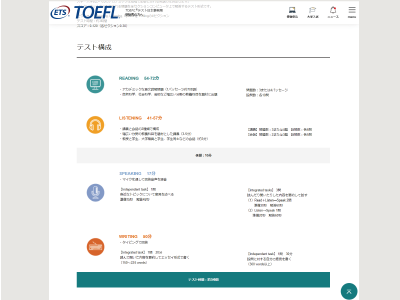TOEFLテストや英語学習を通してグローバル人材になるためのヒントをお届けします。
- トップページ
- ETS公認トレーナー直伝 TOEFL iBT®テスト対策、ここがポイント!
- 第19回 TOEFL iBT®テストスキル向上シリーズ その1 Summarizing Skillについて

2014.09.24
第19回 TOEFL iBT® テストスキル向上シリーズ その1
Summarizing Skill について
皆さんこんにちは。9月に入り、新しい学期や仕事を迎えた人も多かったのではないでしょうか。また留学を目指す人にとってはこれから願書の提出などが迫り、TOEFL iBT® テストの本試験を受ける回数が増えたり、今までより本格的に対策に取り組む必要が出てくるなどするのではないでしょうか。もし不明な点や相談などがありましたら、このページの一番下にある「公認トレーナーに直接訊こう!」のボタンから私に質問できるようになっていますので、よかったら利用してみてください。
さて今回は特定のセクション対策、というよりはTOEFL® テストにおいて非常に重要なSummarizing Skillについてお話します。
なぜSummarizing Skillが必要なのか?
Summarize = 「要約する、集約する」の意味はご存知でしょう。日本語でも、今までに学校で「~を何字以内に要約しなさい」などのような課題を経験した方は多いはずです。
ではなぜTOEFLテストにおいてSummarizing Skillを向上させる必要があるのでしょうか?答えは簡単です。「全セクションにおいてSummarizeを必要とする問題が出題されているから」なのです。具体的には、以下のようになります。
SpeakingにおけるSummarizing
SpeakingではIntegrated Taskの全て、つまりTask 3、4、5、6においてSummarizeが必要になります。
- Task 3 (Read / Listen / Speak about a campus conversation)
Readingで出されるannouncementの内容を要約した後、2人の話者のうち、
どちらかがそのannouncementに対する意見を述べるので、
その意見と理由をまとめる必要があります。 - Task 4 (Read / Listen / Speak about an academic topic)
Readingで出されるacademic articleを読み、そのトピックに関する具体的な
説明や例示のListeningを聞き、両方の情報を統合した上で、
そのトピックがなぜあるのかを要約する必要があります。 - Task 5(Listen / Speak about a campus conversation)
2人の会話を聞き、問題点が何なのかを要約する必要があります。 - Task 6 (Listen / Speak about an academic lecture)
レクチャーを聞き、教授が説明しているトピックについて、
具体例などを交えながら要約する必要があります。
WritingにおけるSummarizing
1つ目のエッセイ問題であるIntegrated Taskにおいて、Readingの主張と理由を3つ、そしてそれに対するListeningの主張と理由を3つ、要約して書く必要があります。
ReadingにおけるSummarizing
パッセージ(本文)中の情報を理解した上で、選択肢の情報と比較して正解を選ぶという作業そのものが、ある程度のSummarizingを必要としますが、特に各パッセージの最後に出題される Prose Summary QuestionにおいてSummarizingは必須です。ここでは
- ・パッセージのタイトル
- ・パッセージ全体の主旨や構成
- ・筆者の態度、トーン
などの情報をすべて集約した上で、選択肢6つのうちSummaryとしてふさわしい3つを選びます。
ListeningにおけるSummarizing
主に1問目に出題されるMain Idea Questionにおいて、会話や講義の目的や主旨を要約して答える必要があります。
以上からわかると思いますが、これから皆さんがますますスコアを伸ばすためにはSummarizing Skillは不可欠なのです。また留学する際にも、色々な場面でSummarizing Skillは役に立ちますので、これを機会に今まで以上に意識して取り組んでみてください。
Summarizing Skill 演習その1
では早速少し練習してみましょう。1回目の練習としては取り組みやすいReading形式で行いましょう。手順としては
- 1) 以下のSample Readingを読む。時間制限はあくまでも目安で構いません。
- 2)ノートやパソコンに、自分なりにSummarizeしてみましょう。特に字数の指示はありませんが、
Readingより長くなってしまわないよう、簡潔にまとめることを意識しましょう。 - 3)その際、a)トピックは何なのか、b)そのトピックに関して主張したい点は何か、を含むようにしてください。
- 4)その後、解説とSample Summaryを参照してください。
それでは書く準備はいいですか?
About ten percent of the world's deserts are composed of sand dunes, which are driven across the desert by the wind. Sand grains march across the desert floor under the influence of strong winds by a process known as saltation. The grains of sand become airborne for a moment, and upon landing they dislodge additional sand grains, which repeat the process. In this manner, sand dunes engulf everything in their path, including structures made by people, and pose a major problem in the construction and maintenance of highways and railroads that cross sandy areas of desert.
(Source: ETS TOEFL Powerprep)
<解説・Sample Summary>
The reading passage describes sand dunes, with particular emphasis on a process called saltation. This process, caused by strong winds, poses a serious threat to human activities by driving sand grains across desserts and destroying many things along the way.
トピックはもちろんsand dunesですが、主張したい点としてはsand dunesが風で運ばれ、あちこちで被害をもたらしているという事です。その辺が含まれていればOKでしょう。
It seems that we apply the term “invention” only to big important items like the car or the telephone. After all, we can hardly imagine surviving without them. We don’t stop to think there are literally hundreds of inventions that make our lives a little easier, a little more convenient. Let’s take something as common as the paper bag, the kind that people put their lunch in. Charles Stilwell in 1883 invented the first machine to produce bags like this. Before Stilwell, bags were pasted together by hand, and they didn’t have flat bottoms so they couldn’t stand on their own and you couldn’t fold them very well either. Stilwell changed all that with what is really a marvelous piece of engineering. Think about how efficiently this bag is designed. You can open it with a flick of your wrist, but you can also fold it back flat as a piece of paper, and you can store a hundred of them under your desk. What’s more, it’s strong - you can even put a heavy dictionary in it and it won’t break, but it’s cheap to produce. Really, it’s a masterpiece of practical engineering. Grocery stores buy over a billion of them every year. Nobody remembers Stilwell nowadays, but his little invention has certainly proved useful.
(Source: ETS TOEFL Powerprepより抜粋、一部修正)
<解説・Sample Summary>
The main argument of the article is how inventions of common items make our lives easier. Particularly, the article describes paper bags as an example of useful inventions. It points out several advantages of paper bags. First, the design is efficient. Opening and folding them is easy. Moreover, they can easily be stocked and thus save space. Additionally, their durability is great. Yet, the production cost is low. Indeed, the article regards paper bags a masterpiece of engineering.
トピックはpaper bags、いわゆる普通の紙袋ですね。全体的なトーンとしては、それがいかに優れた発明品であるか、という流れで続いています。あとは優れた点をいくつかにまとめて説明できると良いでしょう。
さていかがでしたか。また機会をみつけて色々なトピックや形式のSummarizingを練習していきたいと思います。それでは引き続き頑張って学習してください。
それではまた次回(第20回 TOEFL iBT® テスト Listening対策 No.6 ノートテイキング&聴く際の姿勢について)にお会いしましょう。

- 五十峰聖先生
- ETS Authorized Propell® Facilitator
ETS TOEFL ITP® Teacher Development Workshop Facilitator - 桜美林大学 芸術文化群 特任講師
- プロフィールはこちら

- TOEFL iBT®テスト テスト構成
- テストの問題数や内容はテスト構成をご確認ください。




